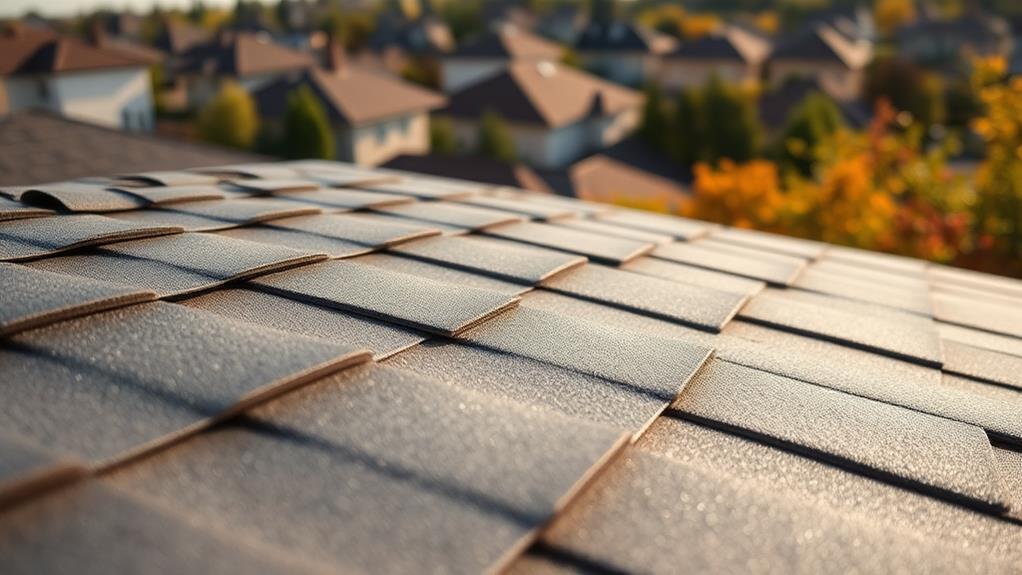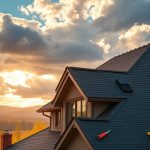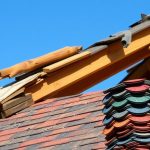Roof coatings for residential roofs play a pivotal role in extending the life of a roof by providing a protective barrier against the elements, such as storms and UV radiation. These coatings, often reflective, contribute to energy efficiency by reducing cooling costs and thermal bridging. Furthermore, the elastic properties of certain coatings prevent cracks and leaks, offering significant weather resistance and leak prevention. In Colorado, specialized services include reflective acrylic and elastomeric solutions tailored to local climate conditions. Proper application is indispensable, involving meticulous preparation and techniques to guarantee a uniform and durable finish. An exploration of these processes can offer deeper insights.
Roofing Highlights
- Roof coatings extend lifespan by protecting against environmental wear and tear, intense weather, and UV radiation damage.
- Coatings enhance energy efficiency by reflecting solar radiation, reducing cooling loads, and minimizing thermal bridging.
- Waterproof roof coatings provide an impermeable barrier, preventing leaks and safeguarding structural integrity.
- Reflective acrylic and elastomeric coatings are tailored for local weather patterns, improving energy efficiency and adaptation to temperature fluctuations.
- Proper application, drying, and curing ensure roof coatings' effectiveness, durability, and optimal weather resistance for residential roofs.
Purpose of Roof Coatings

Roof coatings serve a vital role in residential roofing by considerably extending the lifespan of roofs through protective barriers that guard against environmental wear and tear. They contribute to this longevity by preventing damage associated with storm damage and severe weather conditions, as highlighted in ARCM Roofing's numerous successful projects.
Beyond durability, these coatings play an essential part in enhancing energy efficiency, as they reflect a substantial amount of solar radiation, thereby reducing cooling costs. Additionally, their waterproofing capabilities provide an effective defense against leaks, ensuring the structural integrity of the roof remains uncompromised in various weather conditions.
Extend Roof Lifespan
Many homeowners seek solutions to enhance the longevity of their roofs, and roof coatings emerge as a practical and efficient option. By applying a roof coating, individuals can protect their roofs from the adverse effects of the environment, such as harsh weather conditions, ultraviolet rays, and thermal cycling. Roof coatings add a protective layer, shielding the roofing materials from deterioration and delaying the need for costly repairs or replacements. This preservation technique proves particularly beneficial for communities concerned with maximizing the lifespan of their homes.
Roof coatings often include materials with elastomeric properties, which allow the coating to expand and contract with the roof's natural movements. This adaptability helps to prevent cracks and leaks, thereby reducing moisture penetration and structural damage. Additionally, various coatings come with reflective properties, helping to deflect UV radiation, which considerably contributes to material degradation over time.
Communities that prioritize the health and integrity of their communal spaces can rely on roof coatings as a shared value investment. Emphasizing maintenance today supports sustainability tomorrow, reinforcing a sense of pride and care within the community. Through thoughtful conservation of shared spaces, homeowners not only extend the life of their roofs but also foster a meaningful connection with their home environment.
Enhance Energy Efficiency
Optimizing energy efficiency is a crucial purpose of applying roof coatings on residential properties. Roof coatings offer substantial benefits in managing a home's thermal environment, creating a barrier that reflects solar radiation, thereby reducing the amount of heat transferred into the interior spaces. By doing so, these coatings can drastically reduce the cooling load on air conditioning systems, leading to potentially noticeable reductions in energy consumption and utility costs.
Families often appreciate this cost-efficiency as it aligns with sustainable living goals, creating a sense of responsibility towards the environment that binds them to a broader eco-conscious community.
Moreover, roof coatings enhance energy efficiency by providing uniform surface coverage that diminishes thermal bridging, where heat is lost through conductive materials. High-quality coatings contain reflective pigments that further augment this effect, maintaining cooler roof surfaces even during peak midday temperatures.
This thermal regulation plays a fundamental role in prolonging roof lifespan, indirectly minimizing energy use related to the repairs and replacements associated with deteriorating materials.
In a community where environmental stewardship is valued, embracing such energy-saving technologies engenders a shared commitment among residents to foster not only their personal comfort but also the well-being of the broader environment.
Waterproofing and Leak Prevention
Durability is a paramount advantage of applying roof coatings, specifically in the domain of waterproofing and leak prevention. By utilizing high-quality coatings, homeowners can effectively fortify their roofs against the relentless assault of natural elements, which includes rain, sleet, and snow. The application of these coatings forms an impermeable barrier that actively prevents water from penetrating the roof's surface, thereby safeguarding the structural integrity of the home. By investing in roof coatings, homeowners join a community that values longevity and reduced maintenance, strengthening the ties they have with the structures they call home.
Moreover, roof coatings play a vital role in minimizing wear and tear over time. They extend the lifespan of the roofing material by protecting it against UV radiation and thermal changes, which can otherwise cause materials to degrade and compromise their waterproofing capabilities. Homeowners who seek to belong to a group of responsible, forward-thinking individuals understand the value in preventative measures. Adopting roof coatings as part of regular home maintenance reflects a commitment to sustainable living and future cost savings. By maintaining a leak-free, robust roof, residents can concentrate on enjoying the comfort and security of their home, without the worry of unexpected water damage.
Benefits

Roof coatings serve as a valuable addition to residential rooftops by enhancing energy efficiency through thermal reflectivity, which can drastically reduce cooling costs. When applied to properties such as apartment buildings, they can elevate both functional and aesthetic value.
Additionally, they contribute to the prolonged lifespan of roofs by providing an additional layer of protection against environmental factors that can lead to deterioration. Likewise, these coatings improve weather resistance, offering superior barriers against harsh elements such as rain, wind, and UV radiation, which collectively safeguard the structural integrity of the home.
Enhanced Energy Efficiency
With rising energy costs and increasing environmental awareness, homeowners are actively seeking solutions that offer superior energy efficiency. Roof coatings emerge as a viable option, providing a critical layer of insulation that reflects sunlight, thereby reducing heat absorption. This effectively minimizes the cooling load on homes, which, in turn, translates to significant reductions in energy consumption and utility bills.
Remarkably, reflective roof coatings play an instrumental role in curbing peak energy demand, contributing to a balanced and more sustainable energy grid.
Furthermore, adopting roof coatings aligns with contemporary environmental values, enhancing the eco-friendliness of residential properties. By lowering the need for artificial cooling, these coatings diminish the reliance on fossil-fuel-derived electricity, subsequently lowering the home's carbon footprint. This aligns with broader communal and environmental goals, fostering a sense of shared societal responsibility.
In addition, many roof coatings are formulated to reflect ultraviolet rays, protecting roofing materials from thermal degradation. This not only upholds structural integrity but also augments energy efficiency by maintaining ideal rooftop conditions. Homeowners invested in sustainable living find comfort in knowing their choice contributes positively to energy conservation efforts, fortifying their connection to a community prioritizing environmental stewardship.
Prolonged Roof Lifespan
A key advantage of roof coatings is their ability to greatly extend the lifespan of residential roofs. Roof coatings serve as a protective barrier, shielding the roof surface from various damaging elements such as ultraviolet (UV) rays, moisture, and temperature fluctuations. This supplementary layer of protection not only minimizes wear and tear but also reduces the frequency of costly repairs.
By preventing the accumulation of damage over time, roof coatings effectively delay the degradation process that unprotected roofs endure, consequently promoting longevity and maintaining the structural integrity of the roof.
Moreover, the application of roof coatings contributes to the overall durability of the roofing system by bridging minor cracks and sealing the roof surface. This process helps to prevent water penetration, which is a significant factor in the acceleration of roof deterioration. As a result, homeowners can enjoy a greater sense of security, knowing that their investment is safeguarded against premature failure and the need for early replacement.
The cost-effectiveness of prolonged roof service life also fosters a sense of community wisdom, encouraging practices that benefit not just individual homeowners, but the collective environment as well. This shared understanding elevates community well-being and cohesion.
Weather Resistance Improvement
Enhancing the weather resistance of residential roofs is another significant benefit offered by roof coatings. These coatings serve as a formidable barrier against the elements, effectively safeguarding homes from the adverse effects of weather conditions such as rain, snow, hail, and intense sunlight. By forming a seamless, protective layer over roofing materials, these coatings help to prevent water infiltration, reducing the likelihood of leaks and consequent interior damage. This benefits not only the structural integrity of the roofing system but also guarantees a more secure living environment for residents, fostering a sense of community and belonging.
Moreover, the application of high-quality roof coatings can substantially improve the roof's ability to withstand extreme temperature fluctuations. By reflecting solar radiation, these coatings mitigate thermal stresses on the roofing materials, thereby reducing the risk of cracking and other weather-induced deterioration. This is particularly significant in regions characterized by challenging weather patterns that can otherwise expedite roof degradation. Consequently, homeowners can rest assured that their investment in roof coating not only prolongs structural longevity but also contributes to maintaining efficient energy use within the home, reinforcing a collective commitment to sustainable living practices within the community.
Application Process Explained

Understanding the application process of roof coatings is essential to ensuring their effectiveness and longevity, which involves meticulous surface preparation steps, precise coating application techniques, and an awareness of the necessary drying and curing time. The table below outlines the critical stages and considerations in the application process, including surface preparation procedures, recommended techniques, and expected durations for drying and curing. By adhering to these guidelines, homeowners can achieve ideal performance from their roof coatings, safeguarding their residences from environmental elements.
| Stage | Key Considerations |
|---|---|
| Surface Preparation Steps | Cleaning, Repairs, and Priming |
| Coating Application | Tools, Methods, and Coverage Rates |
| Drying Time | Temperature and Humidity Effects |
| Curing Time | Maximum Strength and Adhesion Achievement |
Surface Preparation Steps
Proper surface preparation is a critical factor in the successful application of roof coatings on residential roofs. This process guarantees ideal adhesion and extends the lifespan of the coating. Initially, inspecting the roof for damage is fundamental. Identifying and repairing any leaks, cracks, or structural weaknesses assures that the surface is sound.
An essential next step is the thorough cleaning of the roof. Removing debris, dirt, and any old coatings is pivotal; pressure washing is often employed for this purpose, ensuring a clean slate for the new coating to properly bond.
Following cleaning, the roof must be completely dry. Moisture within the roofing material can impede adhesion, thus drying time should be thoroughly considered. Upon drying, a detailed evaluation for any remaining imperfections or debris is wise, guaranteeing the surface is free of hindrances.
Priming the roof might be necessary, especially if the surface is particularly porous or previous layers exist. A high-quality primer can greatly improve the coating's adherence and effectiveness. Lastly, taking weather conditions into account is indispensable, as coatings must be applied under suitable climatic conditions for optimal performance. These methodical preparation steps can significantly influence the success of a roof coating project.
Coating Application Techniques
A well-calibrated roller or brush is the artisan's tool in applying roof coatings, guaranteeing uniform distribution across the surface. This meticulous technique is crucial, allowing for exhaustive coverage that fortifies the roof while enhancing its longevity. Ensuring that the equipment is appropriately selected and maintained can drastically influence the final outcome, with particular attention given to the coat's viscosity and the roof's unique contours. With competence, artisans guide the tool, applying consistent pressure to avoid uneven layers that compromise the integrity of the seal.
The crux of this technique lies in maintaining a wet edge. This means working swiftly and methodically across the roof to prevent ridges or lines, which may occur if sections dry before the journey is complete. A methodical approach demands keen awareness of weather conditions, as temperature fluctuations and humidity levels can affect the ease of application.
Professional execution of coating application not only involves the physical act of spreading but also anticipates challenges inherent to the material being used. Understanding these subtleties ensures each stroke contributes to a cohesive barrier that protects the underlying structure. This dedication to detail binds homeowners together, offering a roof that stands resilient against the elements.
Drying and Curing Time
Having deftly applied the roof coating with precision and care, attention must now turn to the critical phases of drying and curing—a process that is equally as important as the application for guaranteeing a robust, long-lasting finish. These phases encompass the gradual shift from a freshly applied state to a securely bonded shield that resists environmental stresses.
Drying signifies the initial evaporation of solvents and water, culminating in a touch-dry surface, often achieved within a few hours under ideal temperature and humidity conditions. Curing, however, is a deeper chemical transformation, integrating the coating with the roofing material to enhance its durability and weather resistance.
Understanding the factors influencing drying and curing times is essential. Temperature fluctuations, humidity levels, and air circulation intricately interact with the coating's composition to determine the timeline. Warm, dry conditions generally expedite both processes, while colder, humid environments might prolong them. Selecting an appropriate time for installation ensures that environmental conditions favor the complete curing of the coating.
Equipped with this knowledge, you can anticipate the enduring protection that a meticulously dried and thoroughly cured roof coating will provide, consequently becoming an integral part of a community that values enduring craftsmanship and architectural resilience.
Connect With Us
Looking to protect and enhance the longevity of your residential roof? Our expert team specializes in high-quality roof coatings that can save you money on energy bills and shield your home from the elements.
Don't wait! Connect with us today to learn more about how our advanced roofing solutions can benefit you. Call us now at (303) 306-8384 for a free consultation and let us help safeguard your home for years to come!
Roofing FAQ
How Long Do Roof Coatings Typically Last Before They Need Reapplication?
The longevity of coatings, prior to necessitating reapplication, generally ranges between five to ten years. This timeframe may vary based on the product used and environmental exposure, fostering a sense of community among homeowners seeking long-lasting solutions.
Are There Specific Roof Coatings Recommended for Solar Panel Installations?
When considering coatings for surfaces supporting solar panels, select those offering superior reflectivity and thermal management. This guarantees ideal energy efficiency and longevity. Consult industry standards and certified professionals for recommendations that align with specific environmental conditions and material compatibility.
What Environmental Benefits Do Roof Coatings Provide?
Roof coatings offer significant environmental benefits, including reducing energy consumption through enhanced insulation. By reflecting sunlight, they lower heat absorption, resulting in decreased urban heat island effect, thereby diminishing overall energy demand and enhancing community sustainability and resilience.
Can Roof Coatings Be Used on All Types of Roofing Materials?
Roof coatings can be applied to various roofing materials, including metal, asphalt, and single-ply membranes. However, compatibility depends on the specific coating formulation and roofing type. Manufacturers' guidelines should be consulted to guarantee seamless integration and performance.
Do Roof Coatings Impact Home Energy Efficiency Significantly?
Increasingly, homeowners seek solutions to enhance energy efficiency. Coatings play a pivotal role in this pursuit, often substantially reducing heat absorption and lowering energy costs. Embracing such innovations fosters not only environmental stewardship but also communal responsibility.




